Meteorological Fall is quickly approaching. Looking ahead, we can already see early signs of the new La Nina influence on the Fall weather patterns in the Northern Hemisphere, growing into Winter 2021/2022.
The meteorological Fall covers 3 months, from September to November. An important player for Fall weather this year will be La Nina again, with a known history of its Autumn impacts. But first, what is this La Nina, and how can it change the global weather for an entire season or two?
BETWEEN THE OCEAN AND THE ATMOSPHERE
La Nina is a cold phase of a large and powerful oceanic oscillation, called ENSO. If you never heard of this ENSO before, don’t worry. In just one minute, we will give you all the information you need.
Now, to keep it simple, ENSO is short for “El Niño Southern Oscillation”. This is a region of the tropical Pacific ocean, which constantly changes between cold and warm phases. The tropical trade winds (winds that circle the Earth near the equator) usually initiate or stop a certain phase, as they mix the ocean surface waters and change the ocean currents.
The image below from NOAA Climate shows the typical circulation during a negative ENSO event (La Nina). Air descends in the eastern Pacific, causing stable and dry weather while rising air in the western Pacific causes frequent thunderstorms and a lot of rainfall.

This way, ENSO has a major impact on the tropical rainfall and pressure patterns, impacting the very “fine-tuned” ocean-atmosphere feedback system. Through this ocean-atmosphere interaction system, the ENSO influence is distributed globally.
We usually observe a global shift in pressure patterns during the emergence and duration of the ENSO phases. Each phase has a unique impact on the tropics and on our weather (with some delay)
The image below shows all the ENSO regions. The main regions are 3 and 4 and together they cover a large part of the equatorial Pacific. However, most analysis and forecast are done for region 3.4, which covers parts of both 3 and 4.
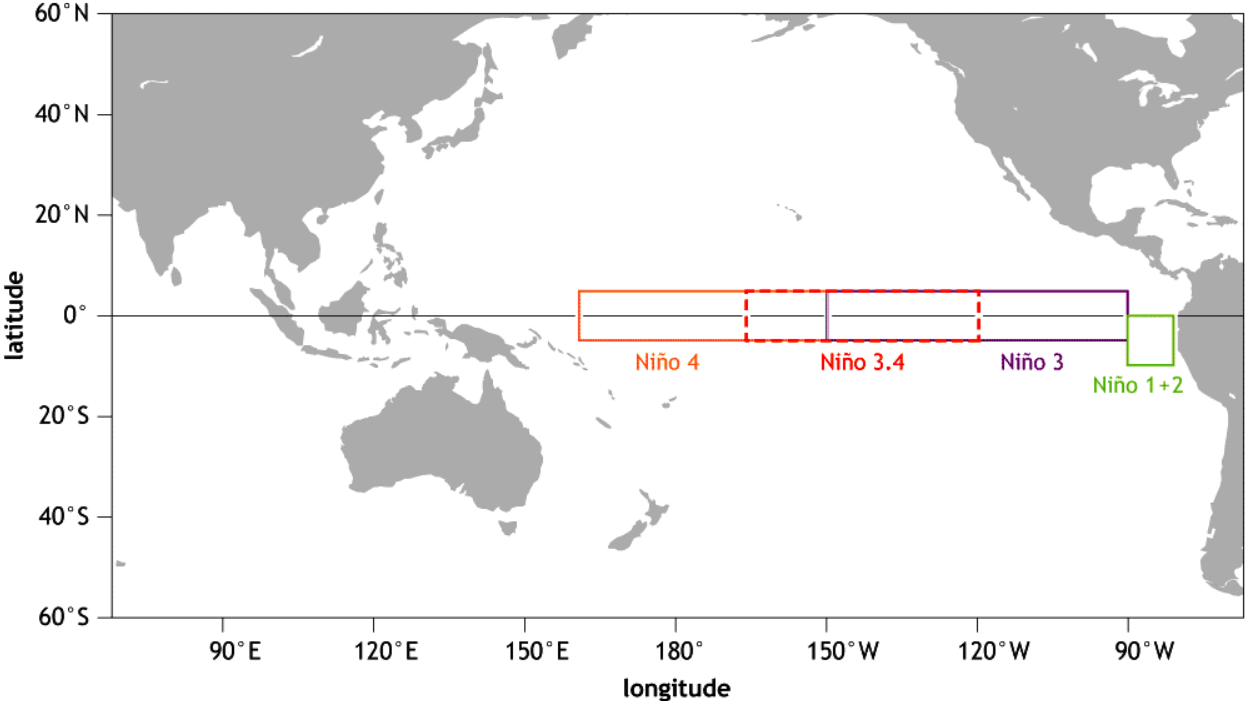
Each ENSO phase has a different influence on the tropical weather and thus having a different impact on the weather worldwide. A specific phase (warm/cold) usually develops around late summer and autumn and can last until next summer, or even up to two years in some cases.
The cold ENSO phase is called La Nina and the warm phase is called El Nino. The ENSO phase is determined by the temperature anomalies (warmer/colder) in the ENSO 3.4 region that you can see in the image above.
The image below shows the current analysis of ocean temperature anomalies, revealing a cold area in the ENSO regions. This is a growing anomaly, starting to appear in July, and expected to grow all the way into Winter 2021/2022.
We can also see a warmer northeast Pacific Ocean and much warmer than normal waters in the Sea of Japan and the northwestern Pacific Ocean.

Below we have a close-up image of the ENSO regions. You can see the developing cold anomalies, having a “wave” shape. This is because of the strong easterly trade winds that push the waters towards the west, swirling the ocean surface.

Some of the cold anomalies in the tropical Pacific are actually left behind by the strong La Nina from last year. It was growing over last Autumn and into Winter, ending this Spring. The image below shows the temperature progression in the ENSO regions, where you can see the first La Nina phase in 2020/2021, ending this Spring.

We produced a high-resolution animation, which shows the ocean temperature anomaly development across the ENSO regions in the Pacific. You can see the cold anomalies of the first La Nina from last year weakening over Spring, and new cooling now starting in July.
The current cooling has been quite substantial and persistent over the past few weeks. The image below shows the sea surface temperatures in the main ENSO 3.4 region. We can see a steady temperature drop since early July, which is expected to continue, with some intermittent warming in-between.

But we have to remove the normal temperatures, to see the actual cooling, and the cold anomaly. The image below shows the temperature anomaly in the ENSO 3.4 region and reveals the ending of the first-year La Nina in Spring, and new cooling starting in July.
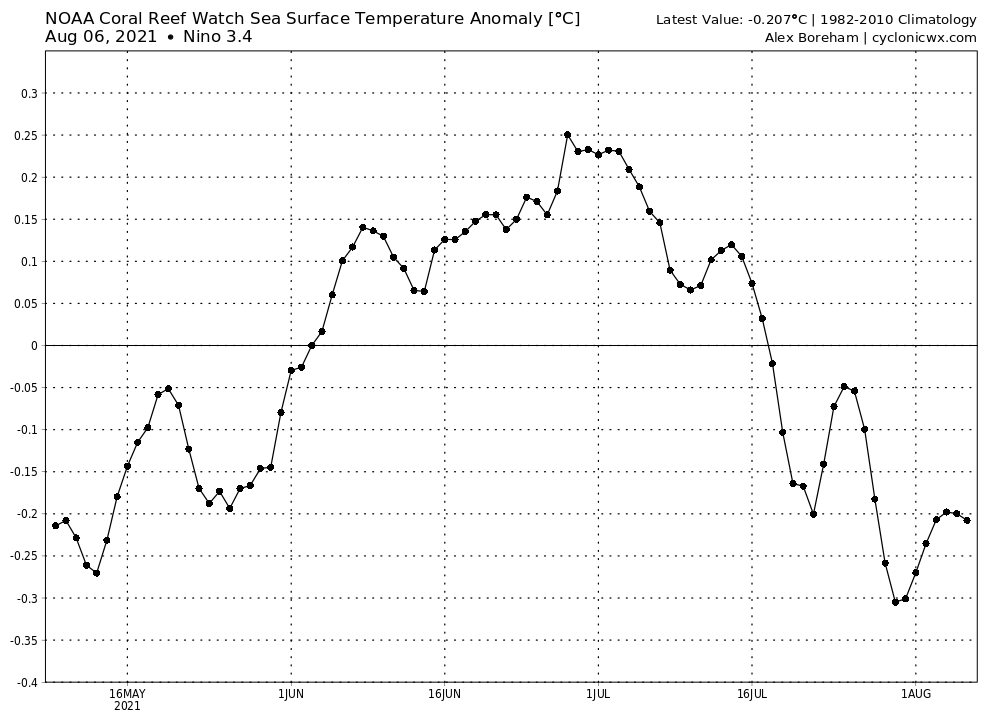
Looking back at last August, the La Nina was slightly stronger and expanded over a wider area over the tropical Pacific Ocean. It had a stronger cold region in the eastern parts, due to stronger trade winds in that region.
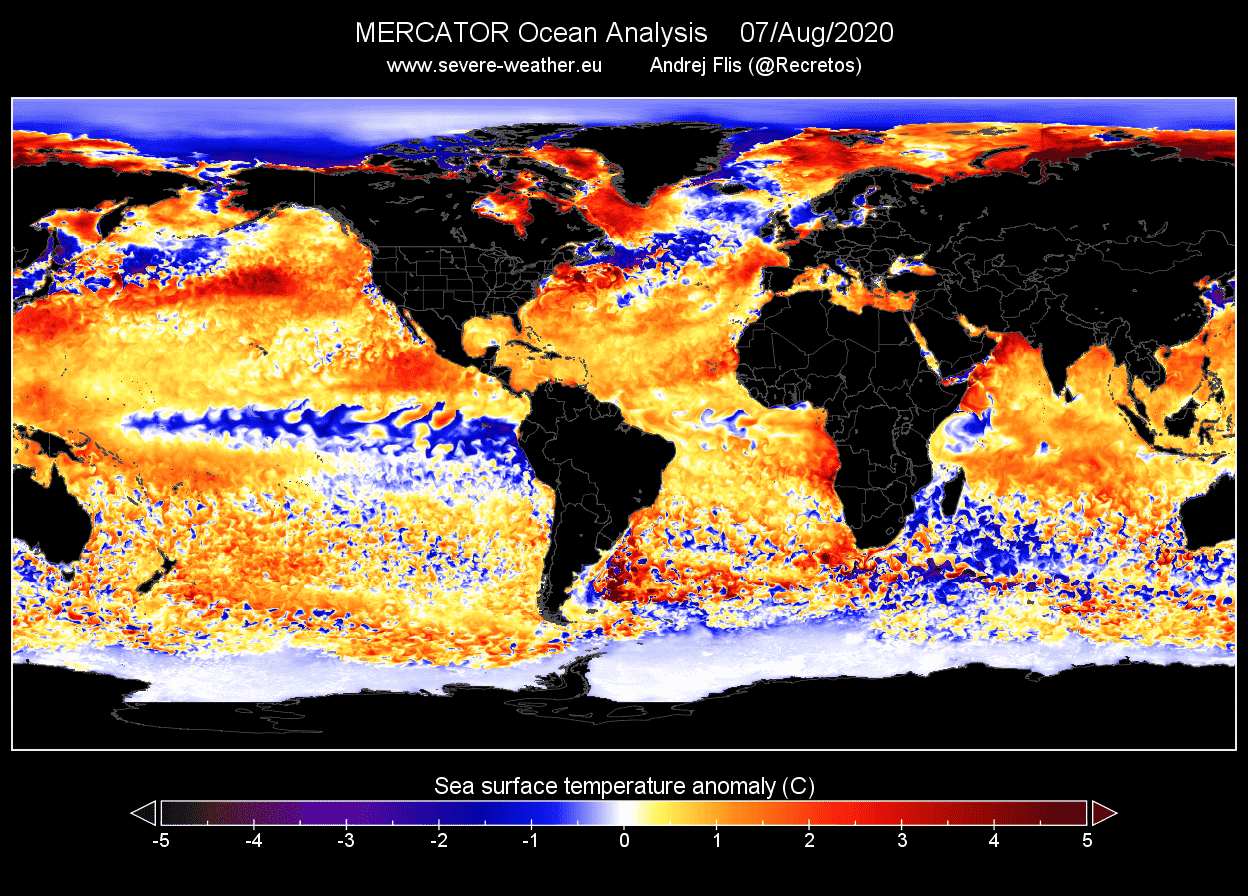
Below we have an analysis/forecast graphic by ECMWF, which shows the forecast of the ENSO 3.4 region. We can see the continued cooling of the tropical Pacific to continue into Autumn and into Winter 2021/2022. The forecast average is staying well in the La Nina phase threshold (-0.5 or colder).

If we look back at the forecast from last August, we can actually see a very similar forecast. Added is a dark blue dashed line, which is the actual verification. We can see that the forecast was actually not cold enough, as the actual La Nina turned out stronger. A similar case is likely this year, as the model is underestimating the developing La Nina.
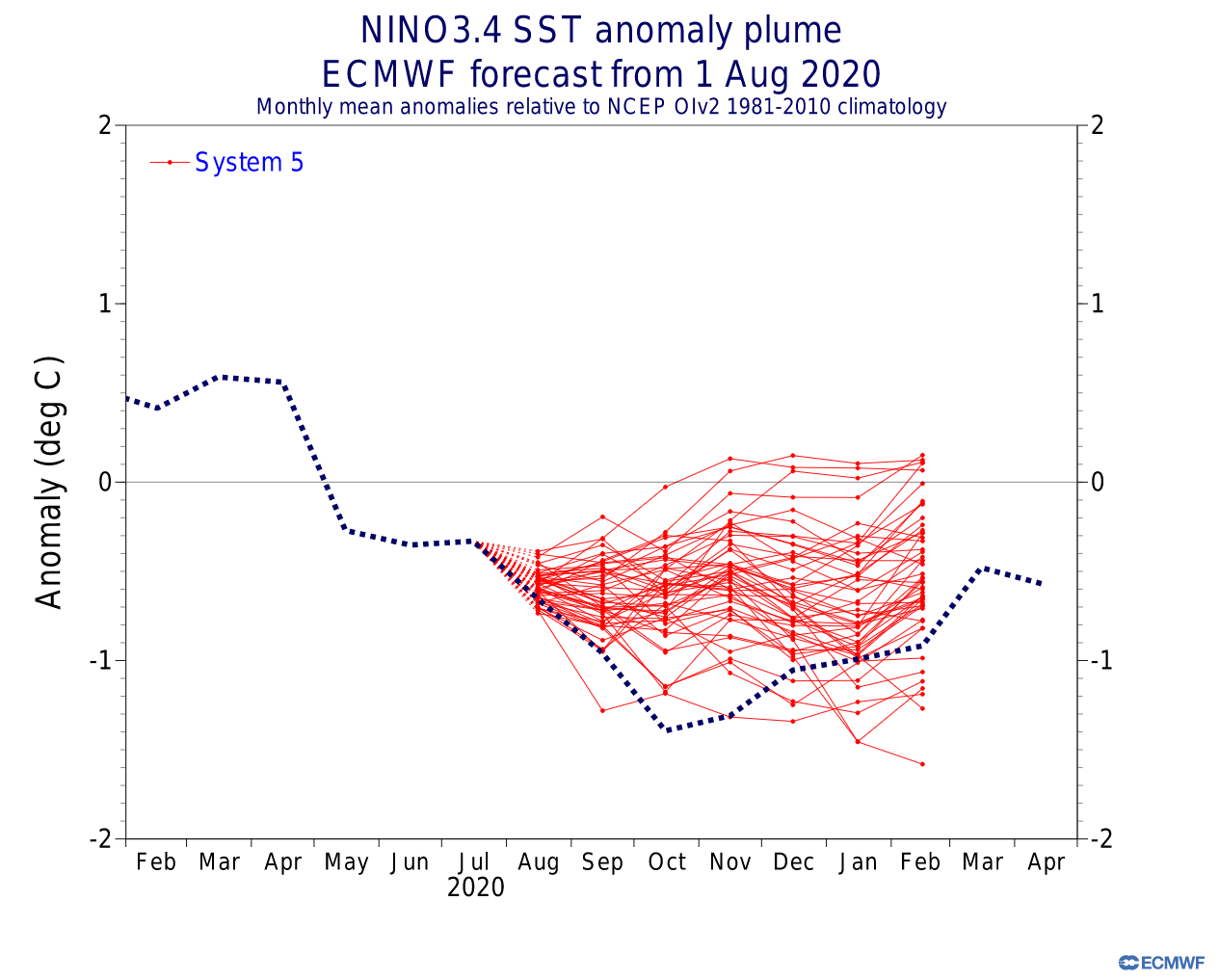
The actual ocean temperature forecast for Autumn 2021 from ECMWF, shows the La Nina is present in the central region. It is not strongly present in the eastern parts, which could have importance for the seasonal weather development, compared to last year.

Another respected ENSO forecast comes from the Australian BOM office. Unlike the ECMWF, it does not underestimate the La Nina, as it has colder anomalies than the ECMWF, lasting into early Winter 2021/2022, weakening towards Spring 2022.
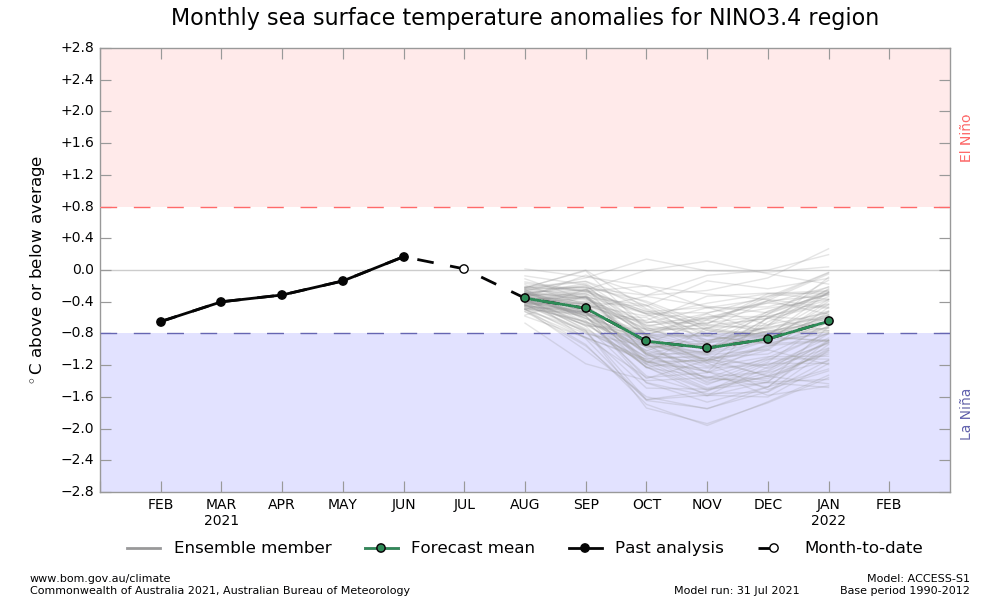
HISTORICAL LA NINA AUTUMN WEATHER
There have been quite a few fall/winter seasons with an active La Nina phase. Counting last year, there were a total of 8 such seasons in the past 25 years.
We produced special graphics, that combine 7 of the La Nina Fall seasons, showing the average weather patterns during a La Nina Fall. We excluded the 2020 Fall season because we will compare it to the historical weather patterns. This will be important to compare to the model forecasts below in the article.
First, we have the pressure anomaly pattern, covering the September-November period. The two features that stand out are the North Atlantic pattern and the Eurasian pressure pattern.

In the North Atlantic, we see a high-pressure system extending from the ocean into eastern Canada and the United States. Above it, we have a lower pressure area extending from Iceland, across Greenland into northern Canada and Alaska.
A strong high-pressure system extends from eastern Europe and Scandinavia into Siberia and the Arctic regions. Another (more iconic) signature of a La Nina presence in Fall and Winter is a high-pressure system in the North Pacific ocean.
Looking at last year, we can see both features. The strong high-pressure system from eastern Europe into Siberia and the Arctic regions. Also, a match is the strong low-pressure system in northern Canada and the high-pressure area from the United States into the North Atlantic.

Looking at the temperature patterns, there is no real surprise about the above-normal temperatures over much of North America, with the exception of the southeast United States. Also of note are the strong warm anomalies in Northern Europe, extending over Siberia into the Arctic regions.
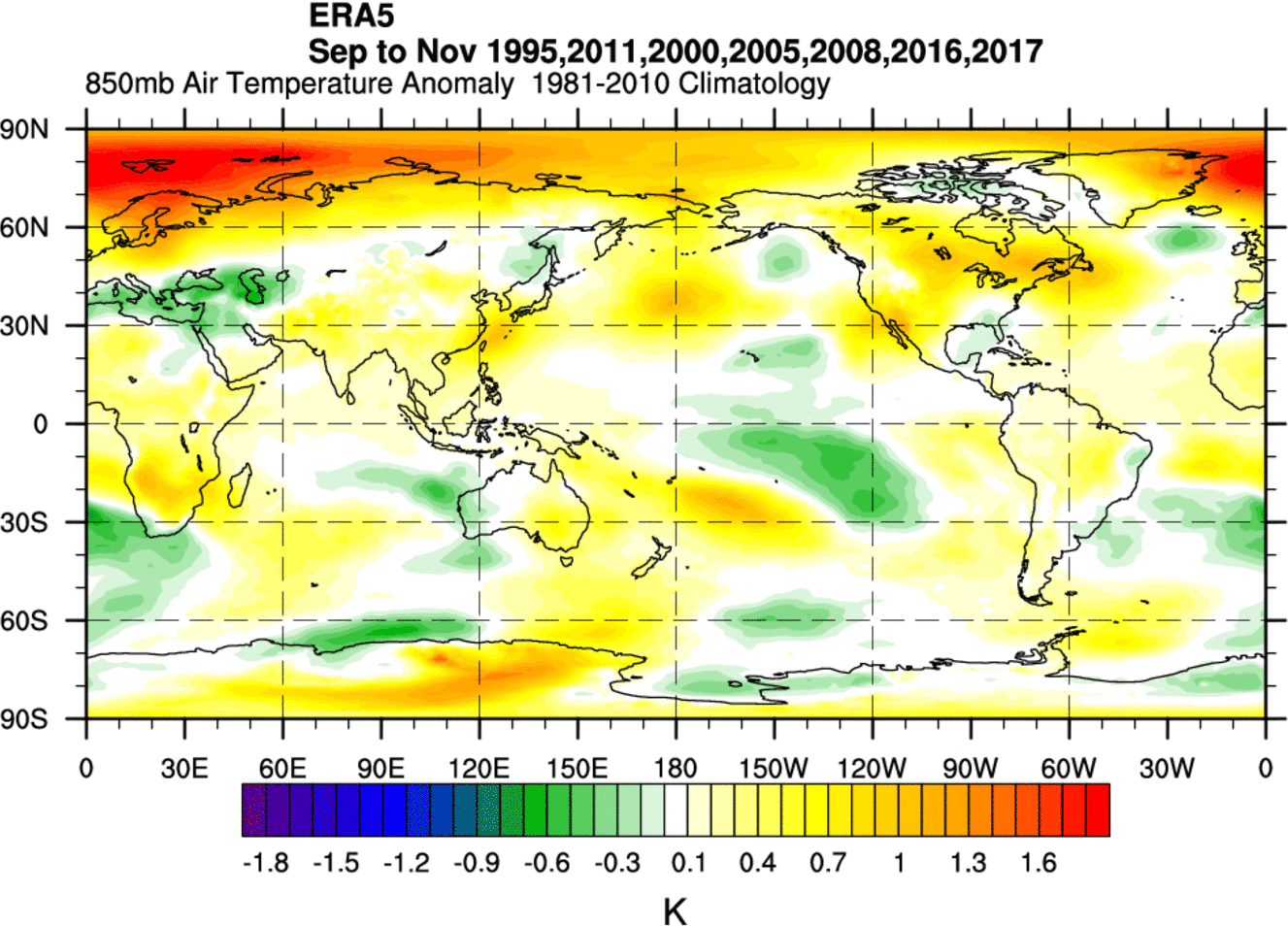
Looking at last Fall below, it was also a good match in temperatures, showing the growing influence of the La Nina. Most of Europe was above normal, with warm anomalies extending into Siberia and the Arctic Ocean.
The main difference was the stronger cold air anomaly over Canada. Much of the United States was warmer than normal, due to the strong low-pressure system towards the north. It produced a more zonal (west-east) flow over the United States, making it harder (but not impossible) for colder air to spill towards the south.

Precipitation patterns in a La Nina Fall season are similar to the temperature patterns. We can see a quite drier than normal situation over most of the United States, except for the east coast and southern Florida. In Europe, the mainlands are drier than normal, but we have more unsettled weather and more rainfall in northwestern and northern Europe.
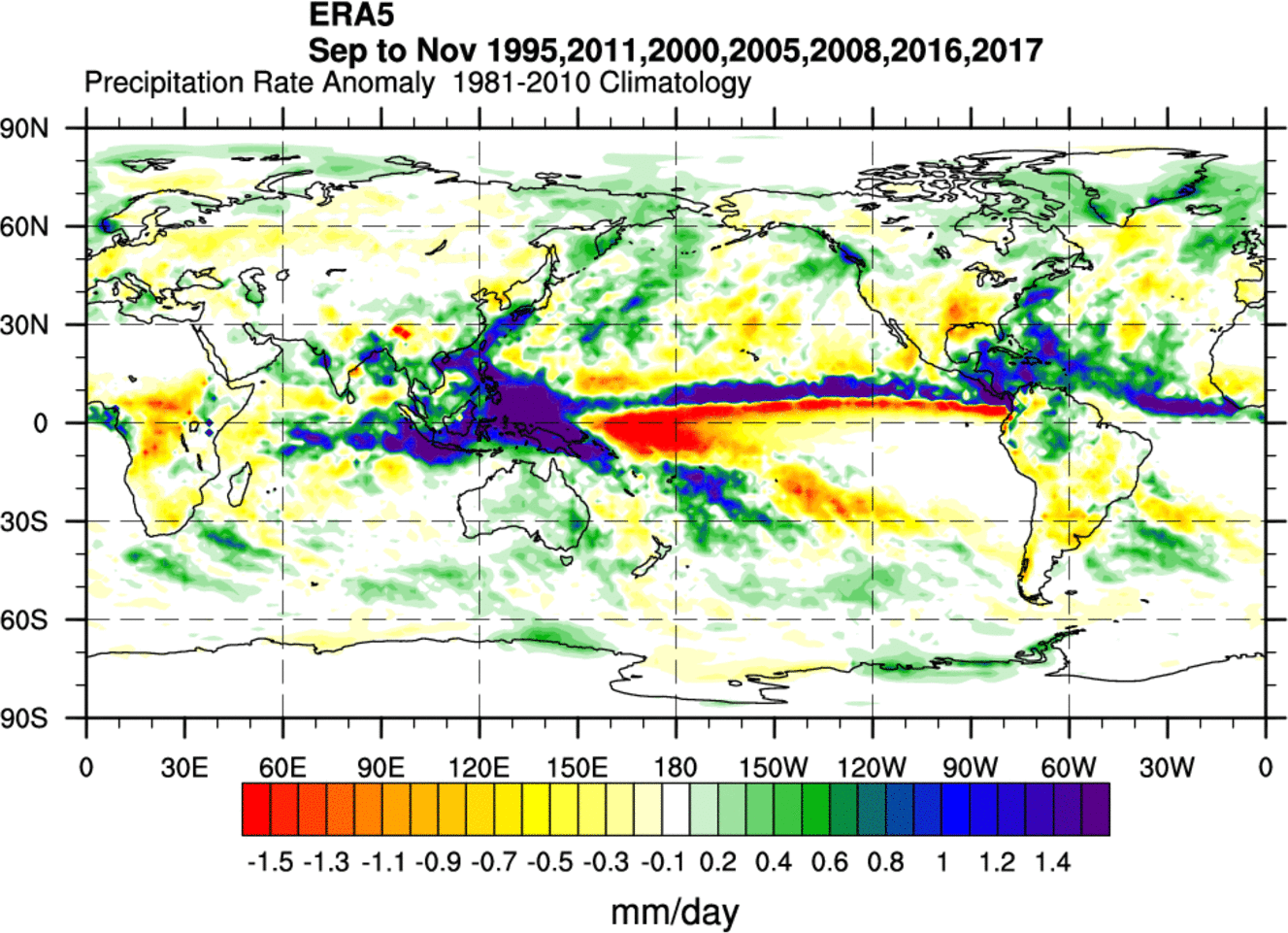
The Fall season last year had a typical La Nina rainfall pattern in the tropics. A dry belt across the equatorial Pacific, and wetter than normal areas in the Caribbean and Indonesia. This is the most obvious sign of the La Nina presence in the tropical circulation.
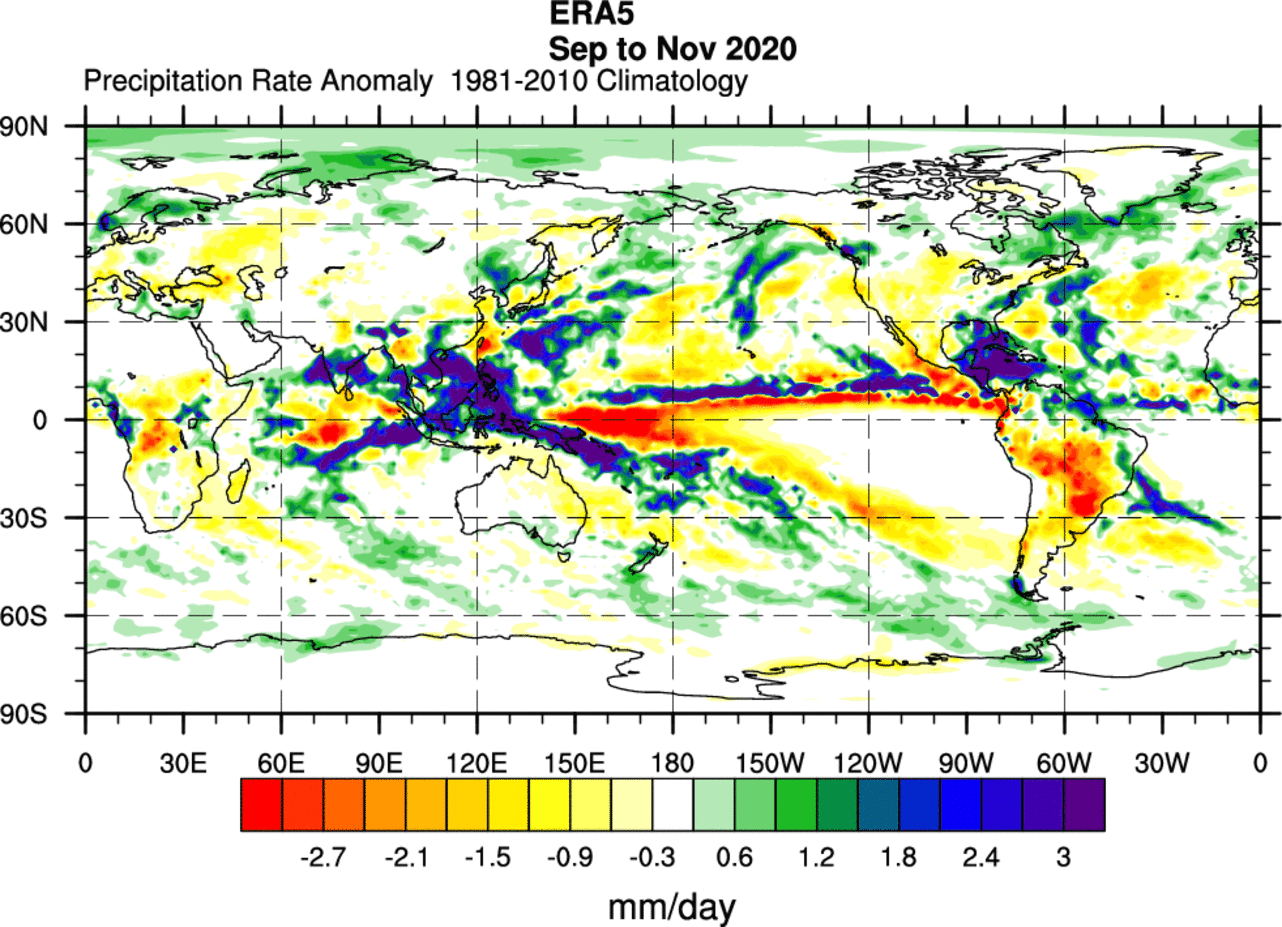
Most of the United States were drier than normal, as expected, with the exception of eastern and southeastern United States. In Europe, we had an unsettled and wetter Fall in northern and northwestern Europe, while most of central Europe was drier than normal.
Knowing what La Nina is and how it can change our weather, we will now look at the actual forecasts, to see if we can find its influence in the coming Fall season 2021.
FALL 2021 LONG-RANGE FORECAST
For the Fall 2021 early forecast, we decided to focus on the 2 main (or most used) seasonal models. The ECMWF from Europe, and the CFSv2 from the United States. Graphics are from the Copernicus Climate EU project and the CPC/NCEP.
All these forecasts are an average picture over the course of 3 months (September-October-November) and show the general prevailing weather pattern forecast. This does not mean that such weather conditions will last for 3 months straight. It only shows/implies how the weather patterns might look 40-60% of the time during the weather season.
ECMWF FORECAST
The ECMWF model is often referred to as the most reliable long-range model. In reality, a lot depends on the individual situation and individual seasons. But generally, the ECMWF model is at the top of the chart as far as reliability goes. But no long-range/seasonal forecast can ever be “reliable”. We are only looking at trends and how the weather patterns might evolve over the entire continents or the whole planet.
The pressure pattern forecast shows the typical La Nina high-pressure system in the North Pacific. But the rest of the Northern Hemisphere does not look like a typical La Nina Fall. Most notable is the lack of a high-pressure system over Scandinavia and a lack of low-pressure over Canada. We see a low-pressure area over the southeastern United States.
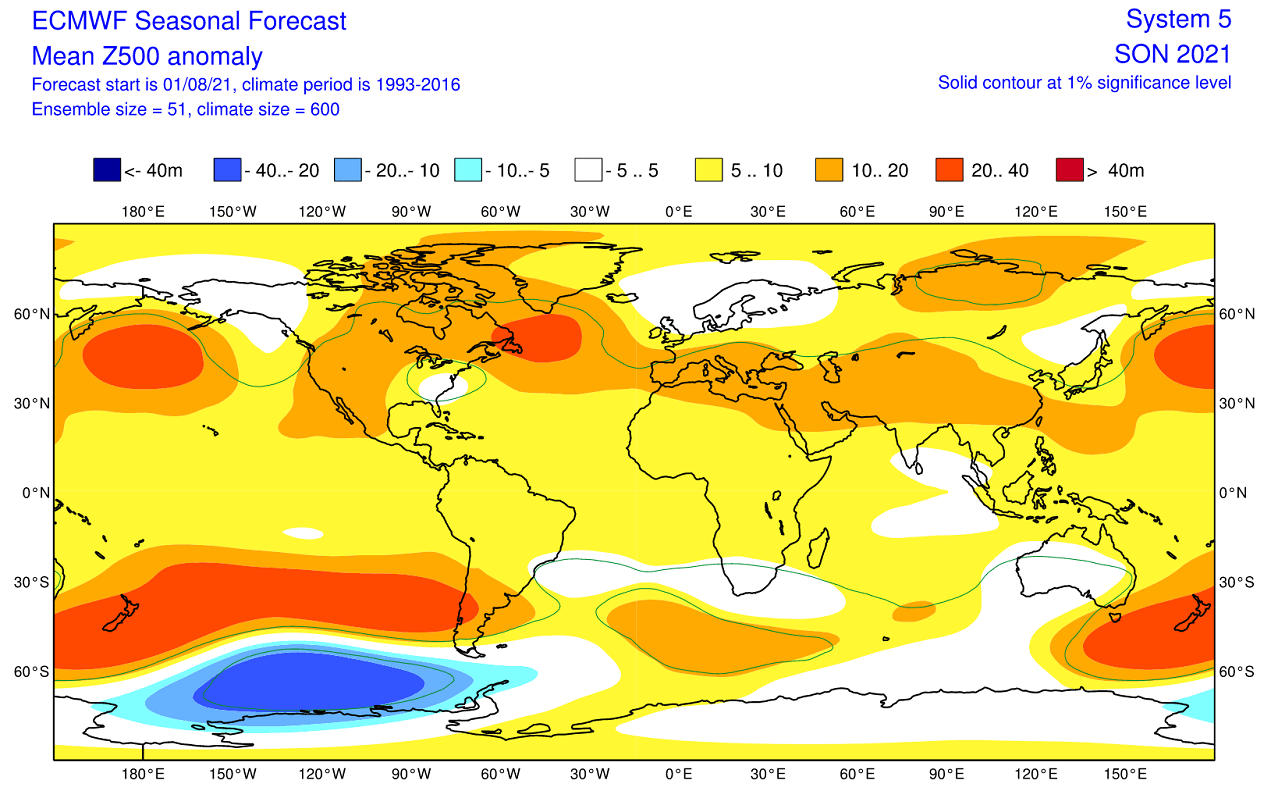
When we look at the airmass temperature anomaly distribution, we can see the warmer Siberia and the warmer western United States. A neutral area is present over the southeastern United States, which corresponds to a La Nina signal. South Canada is warmer than expected, while the north and central European regions show near-normal airmass, likely originating from the Atlantic sector.
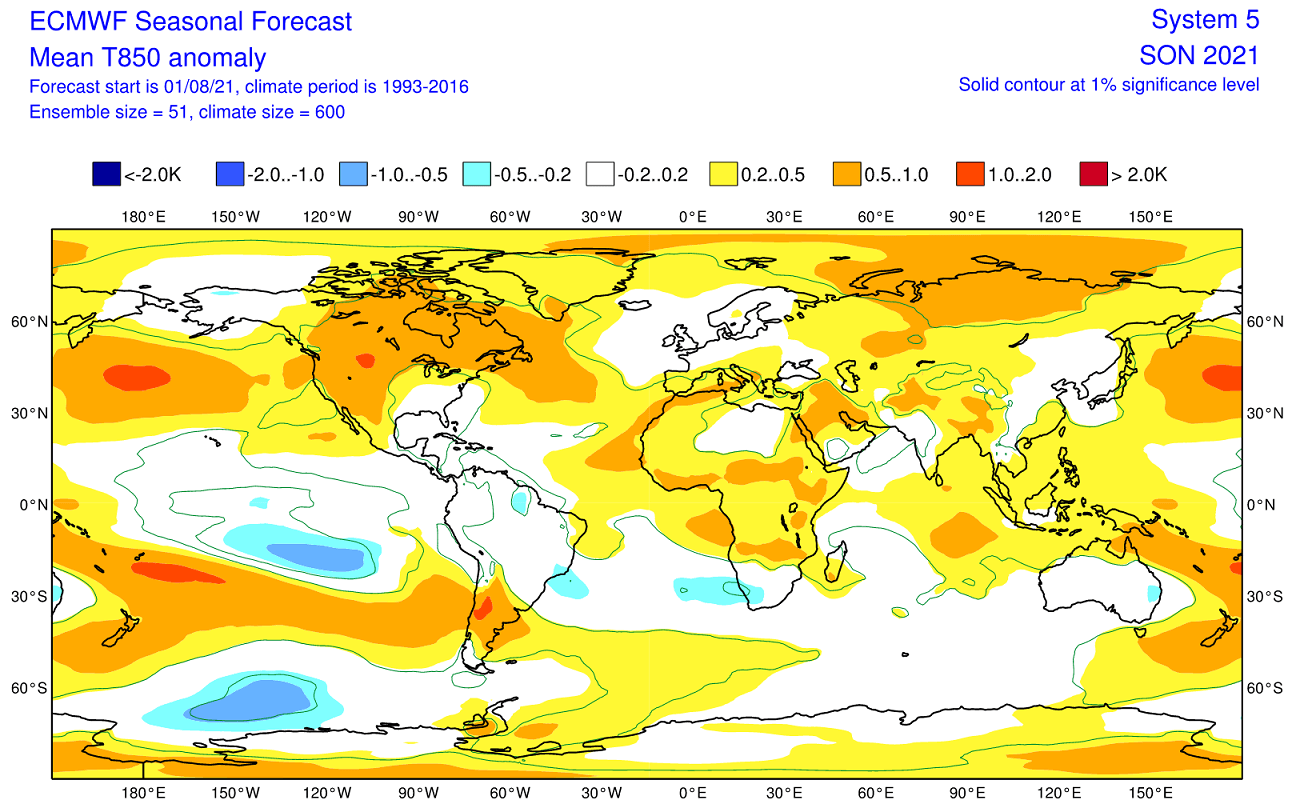
Looking closer at Europe, we can see warmer than normal surface temperatures in southern and east-central Europe. This is likely a continuation of the intense heatwaves present across the Mediterranean regions, under a high-pressure area. The British Isles are around normal temperatures, likely with a more westerly to northwesterly flow.
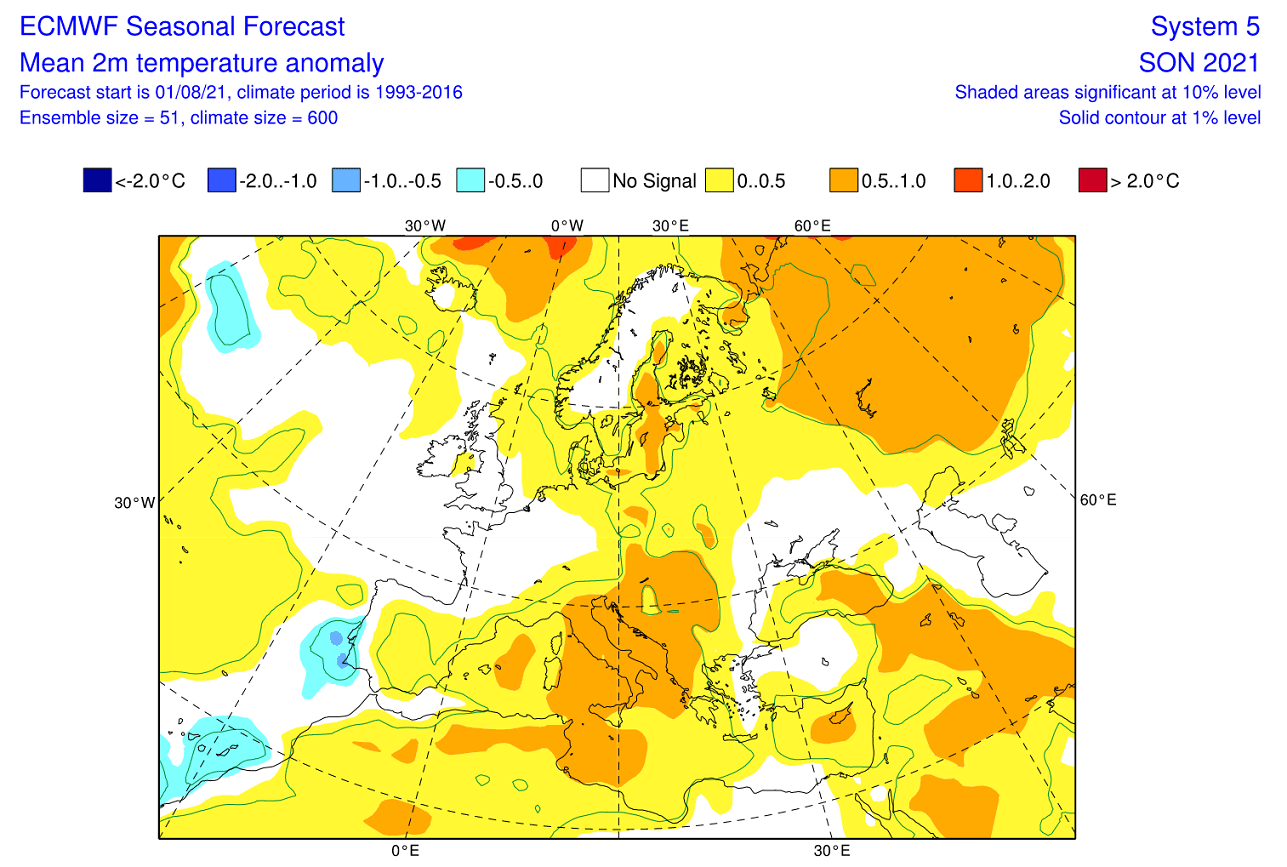
Over North America, we see near-normal temperatures in northern Canada and Alaska. South Canada and the northwestern United States feature much warmer than normal temperatures, with a southerly to westerly flow under a high-pressure system.
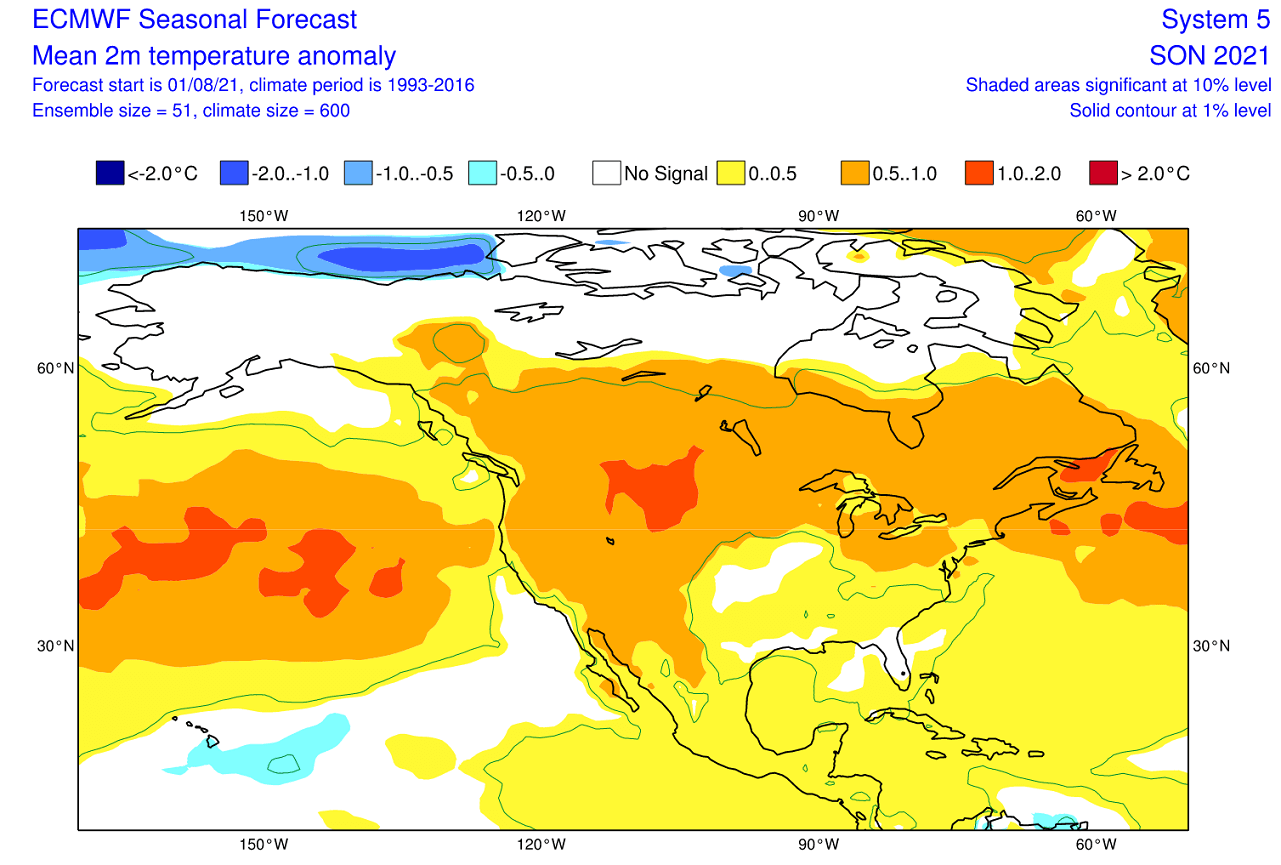
As a contrast, that means more westerly to northwesterly flow over the southeastern United States, keeping temperatures near normal or just slightly higher than normal.
Precipitation-wise, we can see drier conditions in the tropical Pacific Ocean, and wetter conditions in Indonesia and the Philippines. This corresponds to a developing La Nina pattern but is not as well defined in the eastern tropical Pacific.
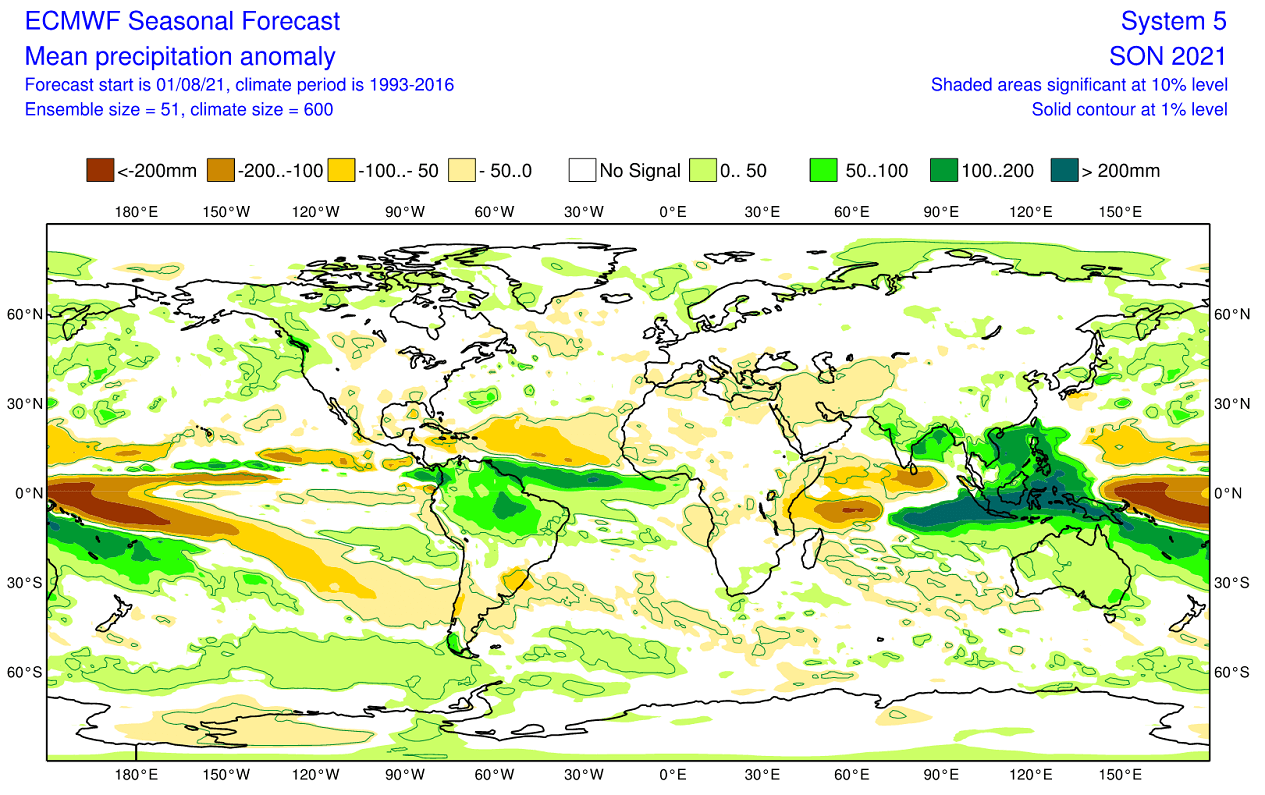
We have wetter conditions over the northwestern United States, reaching into western and northern Canada. The northern and southern United States feature drier conditions. Northern Europe is also normal to wetter under a low-pressure area, while most of the southern regions are dry under a high-pressure area.
It is interesting to see drier than normal conditions in the tropical Atlantic. This is the main development region for tropical systems. We can interpret this as fewer/weaker storms in this region. Tho despite showing drier conditions than normal, tropical systems will still form, and only one strong one is enough for major devastation.
CFSv2 FALL 2021 FORECAST
As a counter-weight, we always tend to use the main North American long-range model, the CFS version 2 from the NOAA/NCEP in the United States. Shown here is the latest forecast update from late July-early August.
The CFS also has a proper La Nina developing over Autumn and into early Winter. The intensity is perhaps just slightly stronger than from the ECMWF forecast, showing a weak to moderate event.

The global pressure pattern is much closer to the ECMWF, with high pressure over the western United States and the central North Atlantic. We also see high-pressure extending out of Siberia into the Arctic regions. Not clearly defined, but the pattern does hint at lower pressure over northern Canada and northern Europe.
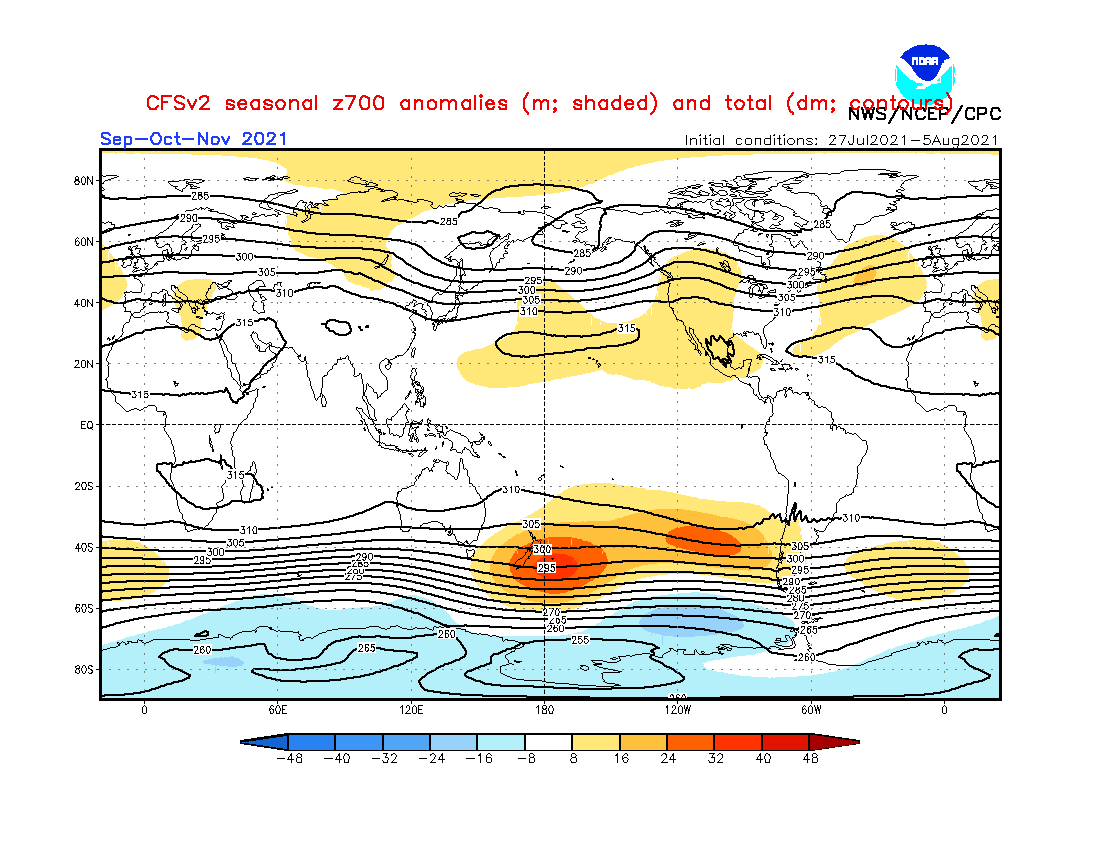
Temperature-wise, we have warmer temperatures over western and northwestern United States, extending into southwestern Canada. Warmer anomalies extend from Siberia into the Arctic Ocean, which was one of the signatures of the typical La Nina Autumn.

Looking closer at Europe, we see warmer temperatures over south-central and eastern Europe. The CFS has much less defined warm anomalies in the Mediterranean and western Europe, compared to the other two models.
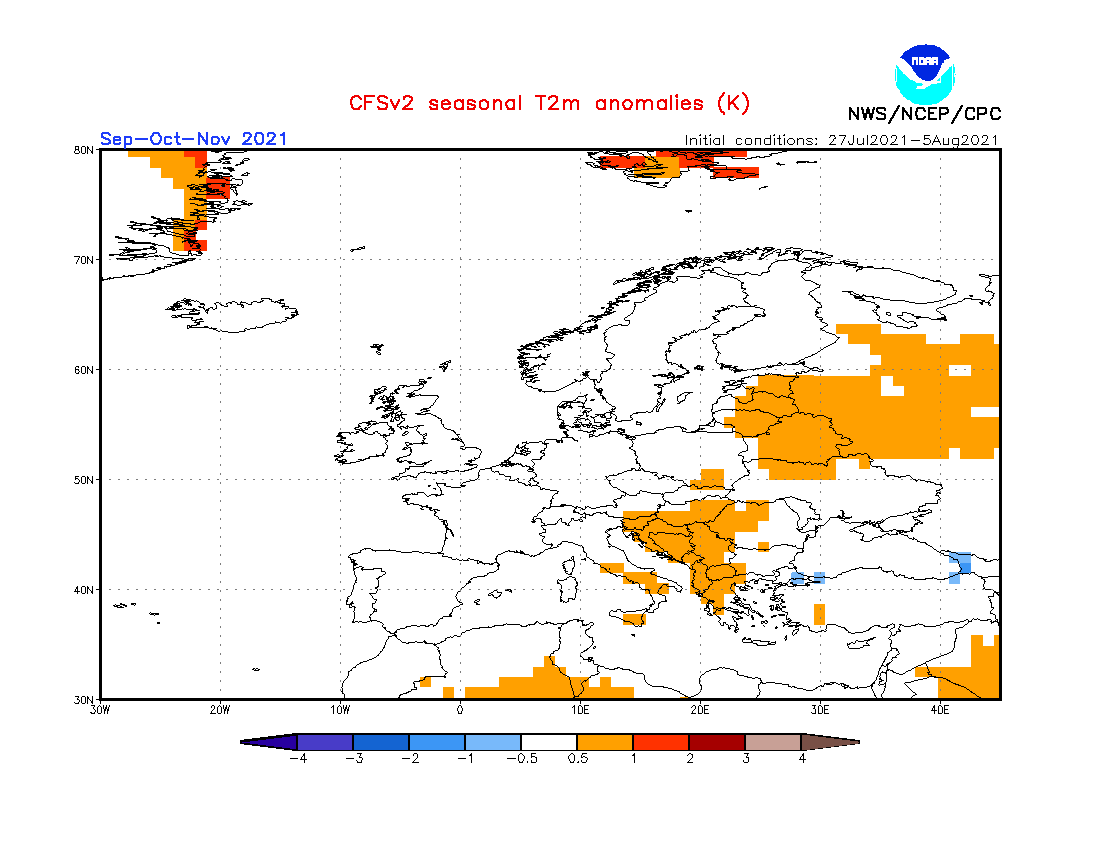
Precipitation-wise, we see normal to wetter conditions over central and northern Europe. At the same time, we have drier conditions over far western and southeastern Europe.

Temperature anomalies over North America look similar to a weak La Nina Fall pattern. Warmer temperatures in the west and north regions of the United States. Normal to colder temperatures prevail under the more northerly flow in the south-central and southeastern parts. Northern Canada is also colder under a low-pressure system.

The more northerly flow also means drier conditions for the eastern half of the country. Drier conditions are also indicated over the northwest, under the more stable conditions of a high-pressure system. Wetter conditions are shown in the moist westerly flow in western Canada.

FALL 2021 EARLY LOOK SUMMARY
Reading images and descriptions can be somewhat confusing. So to summarize, here is what the early model forecasts suggest for the Fall season 2021:
Europe is expected to have warmer than average temperatures over most of the southern half of the continent, with periods of warmer than normal conditions also in central Europe. Early indications show an Indian summer is likely.
This, however, does not mean that there will be no cold fronts and colder late Autumn days. It just implies that cold fronts and colder air mass intrusions will be less frequent over the continent. With a low-pressure system indicated over northern Europe, Scandinavia and the British Isles could see cold Autumn periods appearing earlier than normal.
No big precipitation anomalies are expected over the mainland, with the exception of likely drought conditions extending from Summer into Autumn over southern Europe and the Mediterranean. The British Isles and Scandinavia could see more precipitation in the Autumn season.
North American early Fall forecast shows a high-pressure area is favored over the western United States, extending into Canada, and a lower pressure area over the southeastern United States.
The United States expects to see warmer than normal and drier conditions across the western and northwestern parts. Most of the south-central and eastern United States is expected to contrast the west, and feature normally to even colder than normal temperatures and normal to drier conditions.
Above normal temperatures are also expected over southern and western Canada, but that will change towards the late Fall season.
The La Nina influence is expected to grow later in the season, which means a low-pressure area will start to establish over western Canada. This could mean early snowfall is likely for parts of the northwest and the northern United States.
WINTER 2021/2022 HINTS
We cannot talk about Fall and La Nina, without quickly looking at the Winter hints. We are still far out, and the La Nina is not properly developed yet. But we can look at the typical weather response over North America since it is under its direct influence.
The image below shows the typical position of the jet stream during La Nina winters and the corresponding weather development over North America. The bent jet stream brings colder air and storms down from the north into northern and the northwestern United States, and warmer and drier conditions to the southern parts.
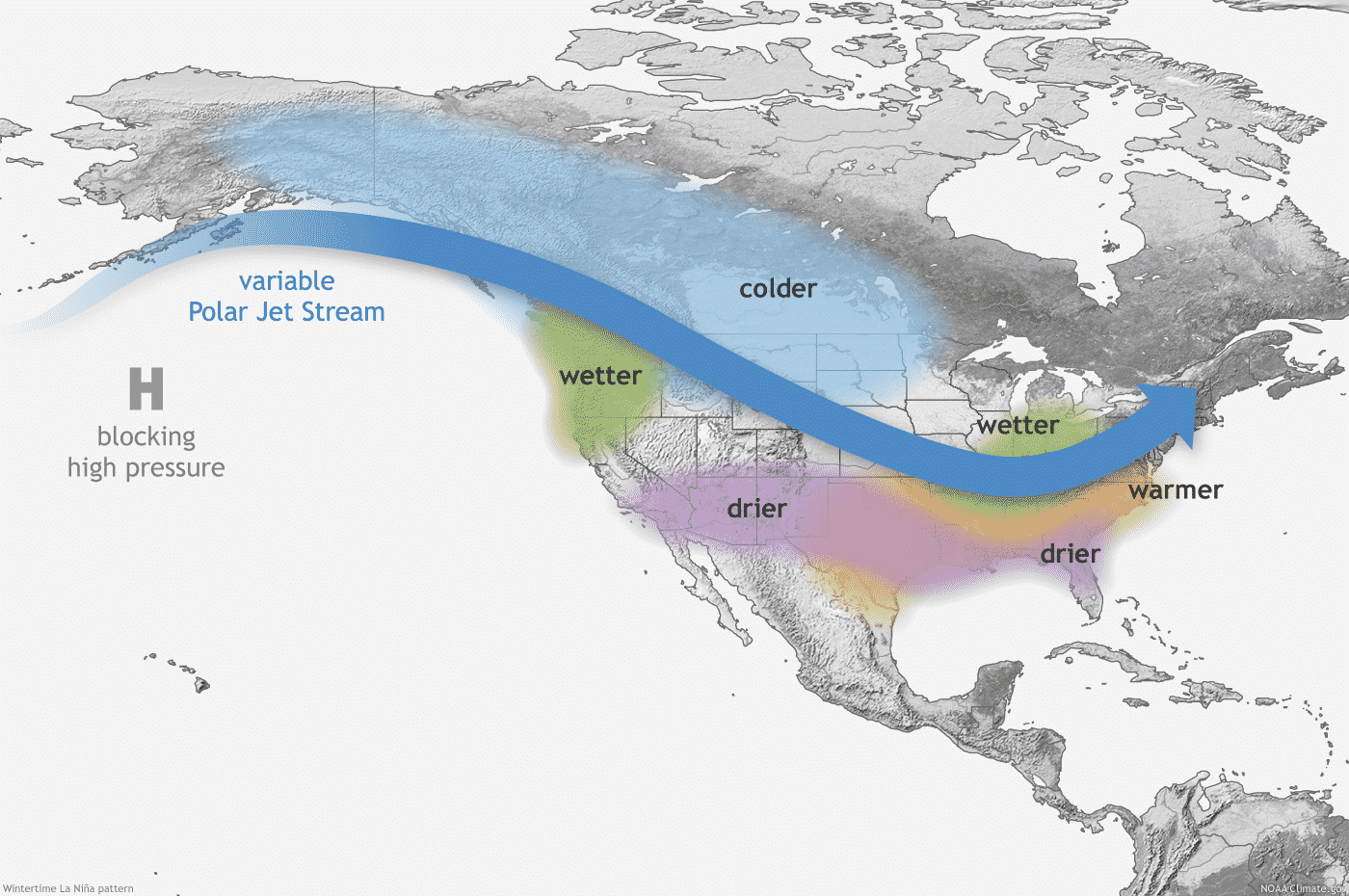
When the jet stream shifts, that also means a different snowfall potential. The colder air is more easily available to the northern United States, which also tends to have an increased snowfall potential during the La Nina years. Especially areas like Alaska, Canada, and the northern United States benefit from the amplified jet stream to produce more snowfall.
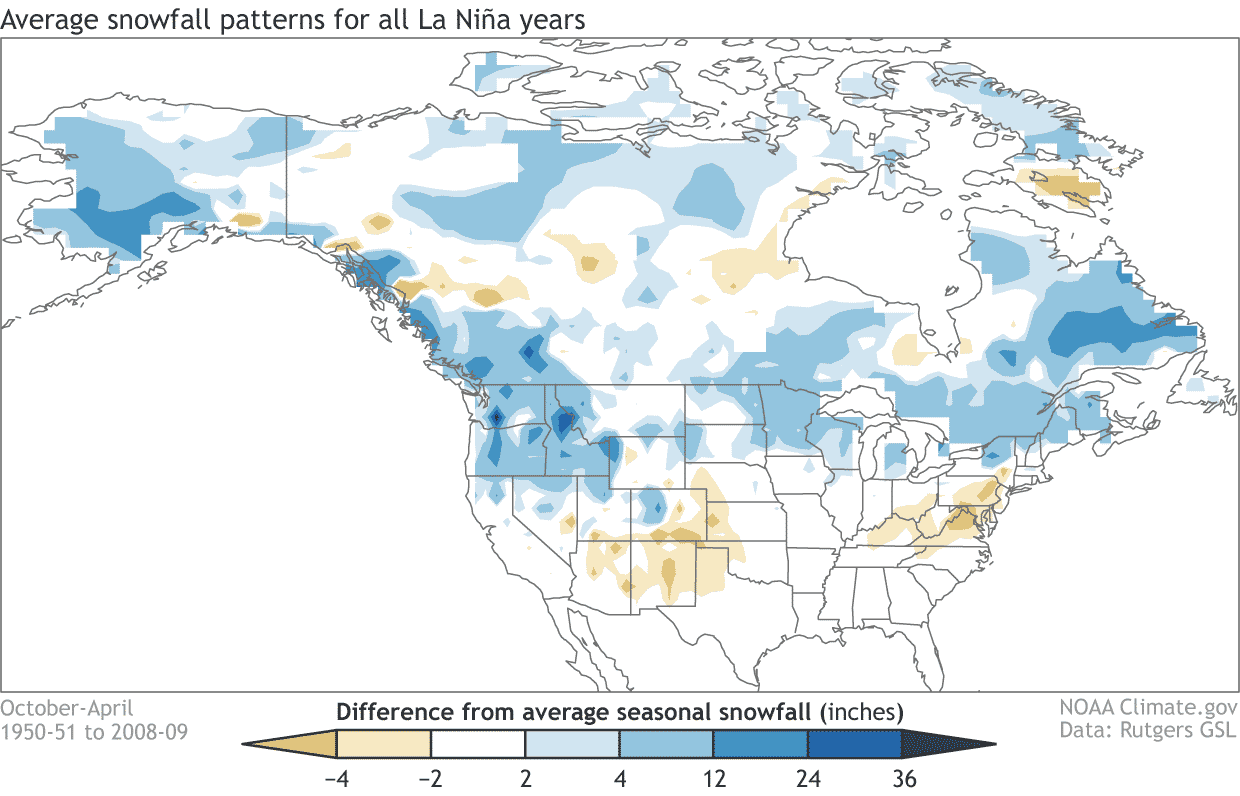
The first pressure pattern forecast for Winter 2021/2022 shows a low-pressure area over western Canada and a strong high-pressure area building in the North Pacific Ocean. We can also see a dominant high-pressure area over Europe.
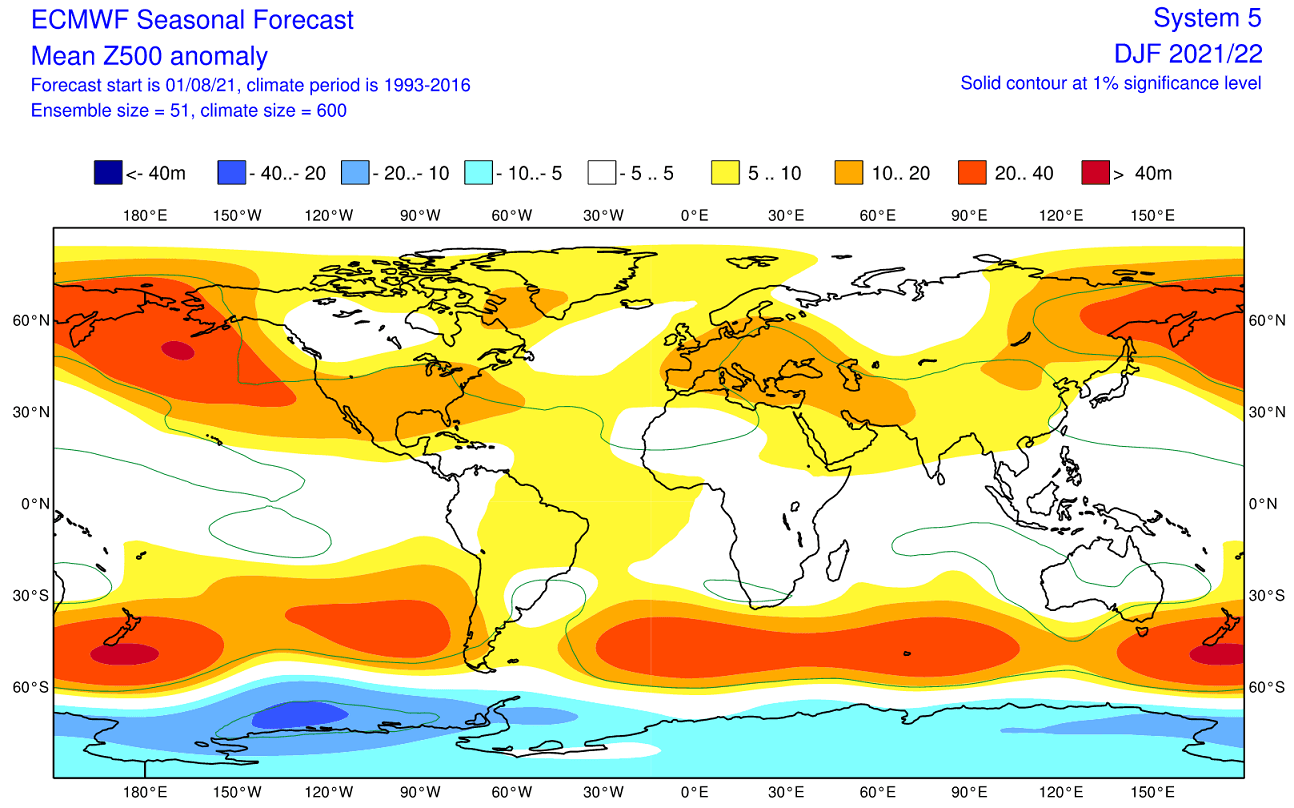
The temperature forecast shows colder temperatures over western Canada, which makes colder air more available for outbreaks into the northern United States. Over Europe, mostly warmer than normal conditions prevail, creating a milder winter.

These are the very first hints for Winter 2021/2022 and are not to be taken for granted. We will release a full early forecast for Winter 2021/2022 around the start of October when the state of the La Nina and its influence will be much better known.
We will keep you updated on the global weather pattern development, so make sure to bookmark our page. Also, if you have seen this article in the Google App (Discover) feed, click the like button (♥) there to see more of our forecasts and our latest articles on weather and nature in general.
SEE ALSO: